garment factories in Vietnam — build smarter with Gavitex
If you’re comparing garment factories in Vietnam, this practical playbook walks you from idea to cartons: materials, fit, timelines, pricing, and how to avoid surprises. I produced a capsule with Gavitex and left impressed—samples hit spec, bulk matched shade and shrinkage targets, and updates were visual and on time.
Quick navigation
- 1. Why brands choose garment factories in Vietnam
- 2. Why Gavitex — audited, responsive, reliable
- 3. CMT, FOB, ODM — which path fits you?
- 4. Capabilities across knitwear, active, denim, outerwear
- 5. Materials & finishes that unlock value
- 6. From tech pack to cartons — the workflow
- 7. Quality systems used by leading garment factories in Vietnam
- 8. MOQ, lead time, logistics
- 9. Market research & colorful chart
- 10. Pricing snapshot (optimized vs. market)
- 11. Case study: from brief to sell‑through
- 12. Frequently asked questions (click to expand)
- 13. Helpful links for garment factories in Vietnam
- 14. Contact to order right now
Why brands choose garment factories in Vietnam
Industrial depth with predictable lead times
Vietnam integrates yarn, knitting, dyeing, trims, packaging, and freight under a dense supply network. That depth lets garment factories in Vietnam combine speed with rigorous quality assurance. For new labels, flexible minimums let you test demand without over‑stocking; once validated, capacity scales with tiered price breaks.
Compliance & workmanship discipline
Experienced garment factories in Vietnam invest in WRAP, BSCI, and ISO. You’ll see capability in pattern making, grading, four‑point fabric inspection, and layered AQL. These habits raise first‑pass yields, reduce rework, and keep deliveries predictable across seasons.
Communication that keeps you in control
Export‑oriented teams share evidence at each gate—PP approvals, lab tests, in‑line photos, and final AQL—so you always know where things stand, even offshore. This transparency is why many buyers prefer garment factories in Vietnam for core and seasonal programs.
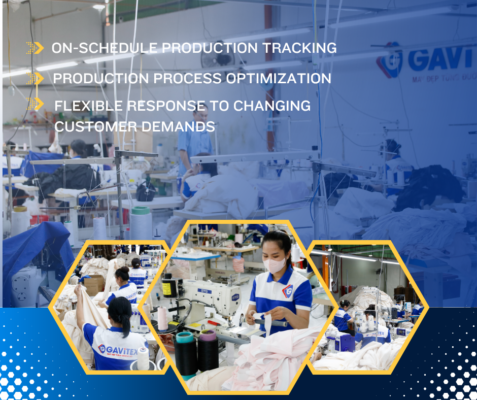
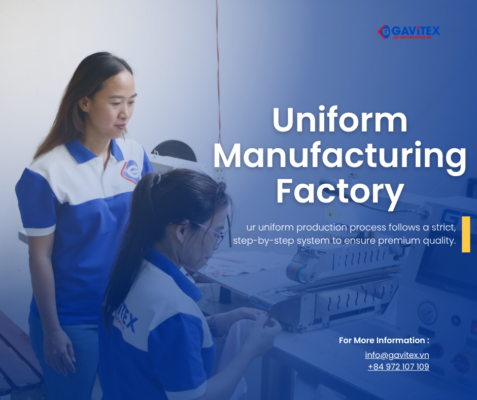
Why Gavitex stands out among garment factories in Vietnam
My real buyer’s story: sampling that mirrored bulk
I arrived seeking dependable garment factories in Vietnam that could balance fit, hand‑feel, and deadlines. Gavitex audited my tech packs line by line, proposed stitch densities, needle choices, and finishing aligned with price targets. Sampling was quick, and the bulk matched the counter sample—shade, shrinkage, label placement, and trims were spot on. Clear updates and pre‑shipment photos gave me the confidence to scale with them.
Value Gavitex adds beyond the needle
- private label clothing from concept to cartons
- OEM garment factory capacity for startups and big‑box retailers
- pattern making to protect silhouette and brand DNA
- quality control layered across intake, in‑line, and final AQL
- sustainable fabrics with pragmatic compliance steps
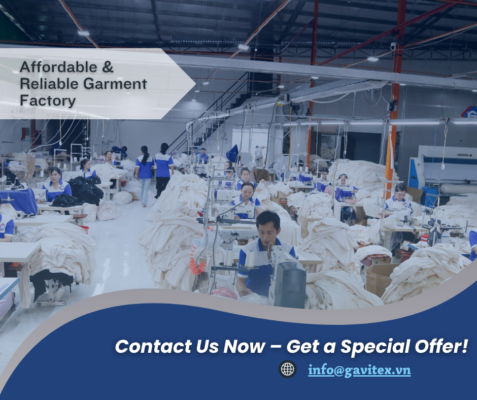

Sourcing models used by garment factories in Vietnam
CMT (Cut‑Make‑Trim)
You procure fabric and trims; the factory cuts, sews, finishes. Among garment factories in Vietnam, CMT suits brands with established supply chains and strict material requirements. Pros: cost transparency, fabric control. Cons: more coordination risk, especially on testing and lead‑time.
FOB (Full Package)
The factory sources materials under your standards and delivers finished goods FOB. Leading garment factories in Vietnam leverage mill relationships for price and speed. Pros: single point of accountability. Cons: requires clear specs and approved libraries.
ODM (Design & Manufacture)
For founders that want speed, ODM lets you tap existing blocks and fabrics tailored by garment factories in Vietnam. Pros: quickest to market, built‑in cost discipline. Cons: less uniqueness unless you customize patterns and trims deeply.
OBM (Own Brand Manufacturing)
Gavitex supports private labels seeking full brand stewardship—assortment planning, packaging, and route‑to‑market advice—grounded in the same rigor that top garment factories in Vietnam use daily.
Tip: If your demand is uncertain, start with ODM for speed, then migrate to FOB as volumes stabilize. This path is common among buyers new to garment factories in Vietnam.
Capabilities that help garment factories in Vietnam deliver
Knitwear & jersey programs
From premium tees to engineered knit panels, garment factories in Vietnam excel in single jersey, rib, interlock, pique, and linking. Gavitex calibrates GSM for drape, opacity, and recovery—vital for women’s tops and men’s essentials.
Activewear & seamless performance
Performance capsules benefit from body‑mapping zones, compression panels, and moisture‑management finishes. Gavitex designs ventilation/support/stability so athletes stay comfortable in motion without transparency issues.
Denim, fleece & outerwear
For structured categories, seasoned garment factories in Vietnam manage wash houses, control shrinkage and shade bands, validate zippers and hardware, and keep topstitch balance tight to avoid puckering.
Embroidery, print & trims
Embroidery, screen and heat‑transfer prints, silicone logos, jacquard, taping, and bonded seams—all tied to test methods that protect comfort and durability.
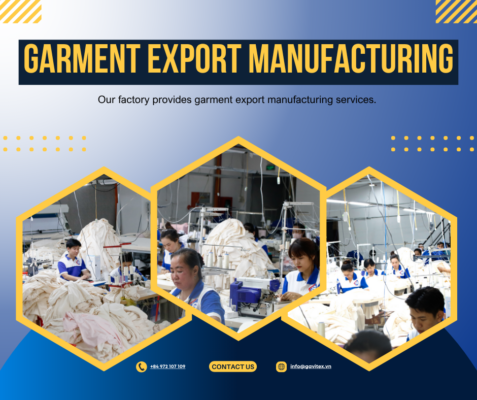
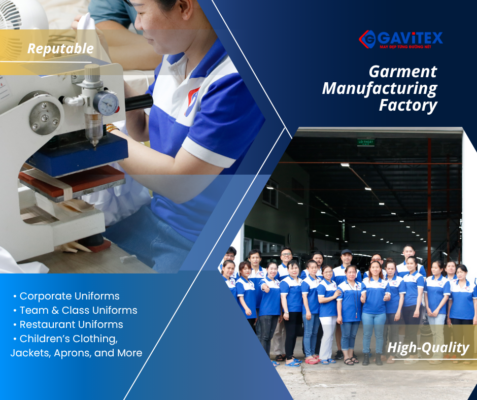
Materials & finishes preferred by garment factories in Vietnam
Core fabric families
cotton jersey, cotton‑spandex, modal blends, poly‑spandex, nylon 6.6, and recycled yarns are widely available. Gavitex helps select GSM for opacity and hand‑feel, then matches trim specs—thread, tape, zippers, interlining—so each garment feels coherent and premium.
Performance upgrades
Choose anti‑odor, quick‑dry, UV protection, and pilling resistance to differentiate in active and outdoor markets. When competing among garment factories in Vietnam, these finishes lift perceived value at retail while protecting comfort.
Brand identity that lasts
For logos, select heat‑transfer, embroidery, silicone prints, or jacquard. Gavitex validates wash‑fastness and stretch recovery so brand marks stay crisp through repeated wear and wash cycles.

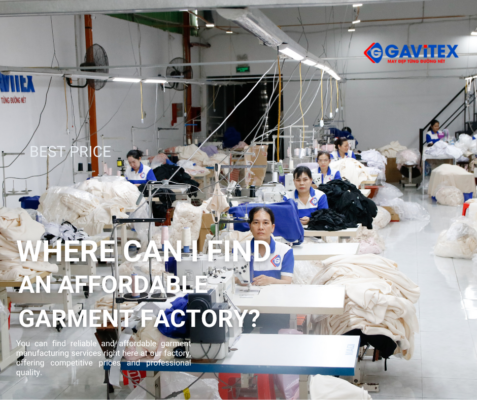
From brief to boxes — a process that protects quality & time
1) Discovery & feasibility
We align on consumer, channels, price points, and hero styles. Unlike generic vendors, the best garment factories in Vietnam flag risks early so sampling is smoother and faster.
2) Tech pack & pattern
Gavitex reviews tech packs, then proposes stitch, needle, and seam constructions. Our pattern making team ensures true‑to‑size fits and market‑specific grading logic. We’ll also suggest seam allowances that respect fabric stretch and recovery.
3) Sampling & fit rounds
We build fit samples, confirm fabrics and trims, and calibrate color standards. For performance lines we tune compression and stretch recovery for comfort and support based on end use.
4) Pre‑production (PP) approvals
PP samples lock workmanship. Shade bands, shrinkage, and finishing specs are documented. This rigor is why many brands nominate Gavitex among top garment factories in Vietnam.
5) Bulk production & in‑line QC
In‑line AQL at cutting, sewing, finishing, and packing keeps bulk aligned to approvals. You’ll receive photo evidence so you stay informed without micromanaging.
6) Final inspection & logistics
Final AQL, carton marking, and handover to your forwarder. We support FOB or EXW according to your routing guide and logistics plan.
Quality systems used by leading garment factories in Vietnam
Inspection layers that catch issues early
Layered control starts with fabric intake (four‑point inspection, lab tests), continues in‑line at cutting, sewing, and finishing, and ends with a final AQL documented by photos. Top garment factories in Vietnam also keep defect paretos to guide corrective action and operator training.
Documents that protect standards
We generate spec sheets, operation breakdowns, and workmanship standards with visuals. This reduces interpretation risk across shifts and sub‑lines—vital when running multi‑color programs at speed.
RSL & compliance
Gavitex supports Restricted Substances compliance and tests for colorfastness, pilling, shrinkage, and tensile strength. Such baselines are why buyers rely on seasoned garment factories in Vietnam for private label scale.
MOQ, lead time & logistics with garment factories in Vietnam
Flexible starting points
For tees and fleece, 400–500 pcs per color is common; leggings and swim may begin at 300–400 pcs driven by dye‑lot size. Denim often counts per wash. As volumes increase, per‑unit cost steps down through tiered breaks—standard among seasoned garment factories in Vietnam.
Lead‑time clarity
Sampling moves quickly when tech packs are complete. Gavitex pre‑books knitting/printing capacity and sequences colors to reduce changeovers, protecting both schedule and consistency.
Labels, packaging & docs
We supply size labels, woven labels, hangtags, polybags, cartons, and paperwork per your routing guide. Pre‑shipment photos arrive before handover so your team can prep listings and logistics.
Market research snapshot for garment factories in Vietnam
The chart below visualizes typical demand shares across categories we see when brands engage garment factories in Vietnam. Use it to plan assortments and forecast MOQs by colorway.
Activewear
Hoodies & fleece
Denim
Dresses
Swim
Kids
Pricing snapshot — optimized ~41% below typical market quotes
To support planning, here is a reference table. Final cost depends on fabric, trims, complexity, and volume. Gavitex keeps quotes competitive so you can retail with confidence among other garment factories in Vietnam.
| Category | Suggested GSM / Fabric | Starting MOQ | Unit price (FOB) | Notes |
|---|---|---|---|---|
| Tees (unisex) | 160–200 GSM cotton / cotton‑spandex | 500 pcs/color | US$2.05–3.10 | Neck tape, enzyme wash, soft hand‑feel options. |
| Active leggings | 240–280 GSM nylon‑spandex | 300 pcs/color | US$5.50–8.60 | Compression mapping, gusset, heat‑transfer logos. |
| Hoodies | 300–360 GSM fleece / French terry | 400 pcs/color | US$7.20–10.60 | Embroidery / screen print; rib and drawcord options. |
| Denim (5‑pocket) | 12–14 oz denim | 300 pcs/wash | US$9.50–14.00 | Wash development; nickel‑free hardware verification. |
| Swimwear sets | 190–220 GSM poly/nylon‑spandex | 400 sets/color | US$5.90–8.90 | Lining, cups, and branded trims available. |
Case study: how we scaled with top garment factories in Vietnam
Brief & goals
The brand needed a 40‑SKU capsule—tees, leggings, hoodies, and a small denim line—targeting mid‑premium pricing. We shortlisted three garment factories in Vietnam, ran time‑and‑action calendars, and asked for counter samples within ten business days.
Sampling & validation
Gavitex won on PP discipline. Fit notes were actioned overnight. Shade bands and shrinkage were documented, and we received live photos at each gate. For leggings, we tested recovery after 50 stretches; for hoodies, we tuned rib ratios to avoid sleeve twist.
Bulk & delivery
The lines hit AQL with margin to spare. Carton labels mirrored the routing guide; 3PL intake was frictionless. Post‑launch, the brand reordered bestsellers within four weeks thanks to fabric positions—a play only seasoned garment factories in Vietnam can pull off consistently.
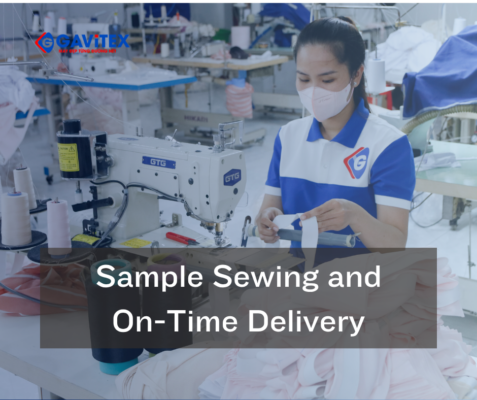
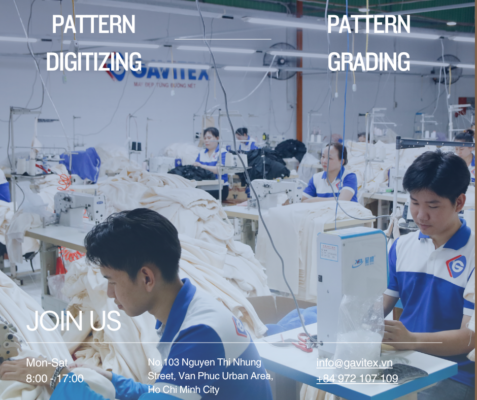
FAQ — working with garment factories in Vietnam
1) I only have sketches — can you translate them into production?
Yes. Start with sketches and any reference garments. Gavitex converts those into tech packs, bills of materials, and a sampling plan with clear checkpoints. We identify risk early—opacity or stretch mismatch, seam stress points, labeling conflicts—then propose alternatives that fit your target price and customer use case. Unlike generic vendors, experienced garment factories in Vietnam document shade bands, shrinkage allowances, and tolerance windows at PP, so bulk mirrors the approved standard. You stay in control with photo updates and fast feedback loops, which means fewer iterations and a quicker route to market.
2) What MOQs should I expect across categories?
Typical starting points: tees and fleece 400–500 pcs per color; leggings and swim 300–400 pcs driven by dye‑lot size; denim counted per wash. These are practical, not rigid. If you are testing, we often bundle colors or share fabric positions across styles to reach economic yardage without inflating inventory risk. Among garment factories in Vietnam, Gavitex focuses on forecasting with you—slotting machine time, reducing changeovers, and using rolling approvals—so each reorder gets cheaper and faster while fit and hand‑feel stay consistent. That balance protects both margin and customer experience.
3) How do you control quality from fabric to final cartons?
We apply layered control: incoming fabric under four‑point inspection and lab tests; in‑line audits at cutting, sewing, pressing, and packing; and a final AQL documented with photos. For performance garments we validate stretch recovery, pilling resistance, and colorfastness to sweat and wash. Many brands choose us over other garment factories in Vietnam because our PP sign‑off is strict—we won’t start bulk without locking workmanship, trims, shade bands, and shrinkage. That discipline lifts first‑pass yield, cuts returns, and preserves your sell‑through when orders scale. We also keep defect paretos to pinpoint root causes and train operators where needed.
4) Can you handle packaging, labels, and barcode requirements?
Absolutely. We supply size labels, woven labels, hangtags, polybags, cartons, and carton markings per your routing guide. Barcodes, FNSKU, and shipping labels are integrated so 3PLs and retailers receive clean scans. Working with garment factories in Vietnam that understand downstream logistics prevents chargebacks and delays. Gavitex also sends pre‑shipment photos so your e‑commerce team can stage product pages and campaigns while goods are en route, shortening time‑to‑live the moment inventory lands. If you ship multichannel, we’ll align inner‑pack counts and carton sizes to both DTC and wholesale needs.
5) How fast can I reorder bestsellers without quality drift?
Once a style is in our library, reorder velocity increases significantly. Fabric and trims are pre‑approved, color standards are locked, and patterns are frozen. We block capacity and plan changeovers to minimize downtime. This is where seasoned garment factories in Vietnam create real leverage: you stay in stock through peaks while competitors scramble. For high‑velocity SKUs we co‑create rolling forecasts and safety‑stock buffers that protect cash flow yet avoid stock‑outs, all while maintaining your fit signature and hand‑feel that keep reviews strong. Reorder SLAs are transparent so your marketing calendar stays in sync with production reality.
Helpful links and internal resources
Ready to collaborate with top garment factories in Vietnam?
Partner with Gavitex for quality, speed, and transparency. Whether you need private label clothing, an agile OEM garment factory, or guidance to upgrade materials and finishes, we’ll help you move from concept to cartons with confidence.
Hotline: 0972107109